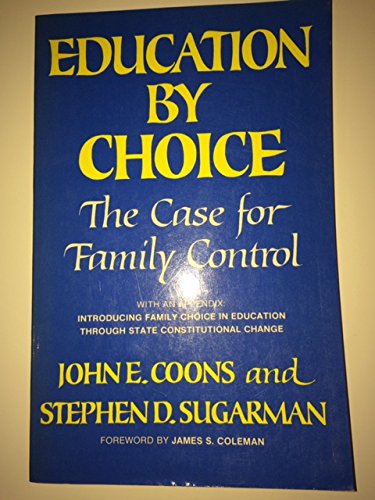
(Guest Post by Matthew Ladner)
Over at RedefinED Jack Coons reflects on the 40th anniversary of the publication of the book Education by Choice with his coauthor Stephen Sugarman. Dr. Coons in some ways too modest, saying that he and his co-author “did not anticipate” Education Savings Accounts, but in effect I believe that they did. Coons and Sugarman envisioned parents, including low-income parents, having the power to create “personally tailored education” for their children, using “divisible educational experiences.” This sounds very close to education savings accounts/multi-provider education to my ears:
To us, a more attractive idea is matching up a child and a series of individual instructors who operate independently from one another. Studying reading in the morning at Ms. Kay’s house, spending two afternoons a week learning a foreign language in Mr. Buxbaum’s electronic laboratory, and going on nature walks and playing tennis the other afternoons under the direction of Mr. Phillips could be a rich package for a ten-year-old. Aside from the educational broker or clearing house which, for a small fee (payable out of the grant to the family), would link these teachers and children, Kay, Buxbaum, and Phillips need have no organizational ties with one another. Nor would all children studying with Kay need to spend time with Buxbaum and Phillips; instead some would do math with Mr. Feller or animal care with Mr. Vetter.
Coons and Sugarman were talking about education, not just schools, in a way that is today becoming increasingly practiced. They wanted parents in the driver’s seat. In “Education by Choice,” they suggest “living-room schools,” “minischools” and “schools without buildings at all.” They describe “educational parks” where small providers could congregate and “have the advantage of some economies of scale without the disadvantages of organizational hierarchy.” They even float the idea of a “mobile school.” Their prescience is remarkable, given that these are among the models ESA supporters envision today.
If you would like to see how parents are already doing this with their own money- see here. If you want an overview of how it is being done in the context of an ESA program-see here. If you would like to see ESAs in action, see here:
Multi-vendor education has been growing in different forms for decades-with families enrolling in after-school/summer programs of various sorts on one end of the spectrum to full blown homeschooling with multiple service providers on the other. Coons and Sugarman were way ahead of their time, and this is just getting started.

While the concept is lovely and enticing for some, it ignores completely the realities of so many aspects of public education. Public Education has evolved in to far more than just learning. When all parents in the home have jobs, Day Care functions are critical. When lower income families are involved, providing food is a challenge our nation has taken on. Special Education kids’ rights add to the complex challenge as well as kids whose families only speak Spanish at home (or any other non-English language).
However . . the a la carte menu still makes sense. Education Centers on land already owned by the public could be scattered across Scottsdale. The unused capacity of the SUSD Campus network could and should be made available at a Fair Market rate for all types of education service providers.
Just as the Food Court has evolved where shopping centers used to sit empty, Education Centers could fill the half empty campuses of SUSD that are threatened with consolidation.
How great would it be if a parent could choose from a menu of services at each campus? From Charters, Public, Private, Arts, Theater, Dance, Athletics, and whatever else the market wants to buy?
Reversing the horrendous public image of Scottsdale as the Education Center of Corruption and turning our town in to a Mecca for enlightened education of every student is a challenge worth taking on.
Even better, we would stop the building boom that threatens to ravage our City. And we would stop the preposterous appropriation of public funds by Charters’ shareholders owning campuses built with public taxes.
Win win win – and yet so emotionally charged.
Mike-
If the state gave every kid an account weighted by special program status and family income, what you describe would likely unfold with parental demand shaping the universe of options between full time/part time, specialized/general programs. In the absence of it, multi-vendor education is happening anyway among those who can afford it-including among students attending SUSD. So for instance in my neighborhood there is a Mathnasium just down the street from Arcadia HS, Kumon a couple of miles away etc.